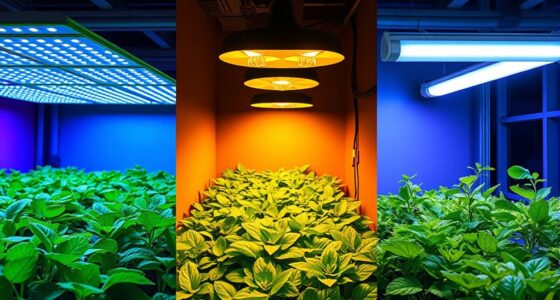In recirculating systems, understanding nitrate and ammonium is key. Nitrate (NO₃⁻) is stable, soluble, and less toxic, acting as a long-term nitrogen reservoir. Ammonium (NH₄⁺) is more reactive and can be toxic at high levels, especially with pH and temperature changes. Biological filtration converts ammonium into nitrate efficiently. Knowing their differences helps you manage system health and prevent issues, and discovering more about their properties will help you optimize your system effectively.
Key Takeaways
- Nitrate (NO₃⁻) is a stable, highly soluble form of nitrogen that accumulates over time in recirculating systems.
- Ammonium (NH₄⁺) is more reactive and toxic, produced directly from waste and organic decay.
- Biological filtration converts toxic ammonium into less harmful nitrate, maintaining system balance.
- Monitoring nitrate helps assess long-term nitrogen levels, while ammonium requires immediate management to prevent toxicity.
- Proper nitrogen management supports healthy aquatic environments and prevents issues like algae blooms or organism stress.

Have you ever wondered how nitrogen exists in different forms in the environment? It’s a fascinating process that plays a pivotal role in aquatic systems, especially when you’re managing recirculating aquaculture or hydroponic systems. Nitrogen primarily appears as nitrate (NO₃⁻) and ammonium (NH₄⁺), each with distinct properties and implications for your system’s health. Understanding their differences helps you maximize conditions, prevent toxicity, and promote healthy growth.
Discover how nitrate and ammonium influence aquatic health and system management.
Nitrate is the more stable form of nitrogen in aquatic environments. It results from the nitrification process, where bacteria convert ammonium into nitrite (NO₂⁻) and then into nitrate. Because nitrate is highly soluble and less toxic, it tends to accumulate in systems if not managed properly. While plants can use nitrate efficiently, excess amounts can lead to issues like algae blooms or poor water quality. Nitrate’s stability makes it a reliable indicator of ongoing nitrogen cycling, but it also means you need to monitor and control its levels regularly. If nitrate levels become too high, it can stress aquatic life and inhibit growth, so keeping it in check is essential.
In contrast, ammonium exists in a more reactive and often more toxic state. It’s produced directly from waste excretion by fish or other aquatic organisms and from organic matter decomposition. Ammonium’s toxicity depends on pH and temperature but generally poses a greater risk to your system’s inhabitants at elevated levels. Interestingly, ammonium can be used directly by plants, especially in hydroponic setups, sometimes providing a quick nitrogen source. However, in recirculating systems, excess ammonium can quickly cause stress or even mortality among fish, so maintaining balance is key.
The key difference lies in their behavior and impact on your system. Nitrate, being less toxic, tends to be a long-term reservoir of nitrogen, but it requires careful monitoring to prevent buildup. Ammonium, on the other hand, demands immediate attention when detected because of its toxicity. In a well-managed recirculating system, you want to keep ammonium levels low while allowing nitrifying bacteria to convert it efficiently into nitrate. This delicate balance ensures your aquatic environment remains stable and healthy, supporting ideal growth for your fish and plants.
Additionally, understanding the properties of nitrogen compounds can help optimize biological filtration and system management strategies for better aquatic health.
Frequently Asked Questions
How Do Nitrogen Forms Affect Fish Health in Recirculating Systems?
You might notice that high levels of ammonium can stress your fish, causing gill damage and reducing their immunity. Nitrate, on the other hand, is less toxic but can still impact fish health if it accumulates too much over time. Maintaining balanced nitrogen levels through proper filtration and regular testing helps make sure your fish stay healthy, minimizing stress and preventing disease in your recirculating system.
Can Nitrogen Form Shifts Indicate System Imbalance or Malfunction?
Think of your recirculating system as a car’s engine; sudden shifts in nitrogen forms are like warning lights flickering on your dashboard. If ammonium suddenly spikes while nitrate drops, it signals a potential malfunction or imbalance, like clogged filters or oxygen deficits. Regular monitoring helps catch these shifts early, allowing you to troubleshoot before they cause serious issues, ensuring your system runs smoothly and your fish stay healthy.
What Are the Best Methods to Monitor Nitrogen Species Continuously?
You should use online sensors or analyzers designed for continuous nitrogen monitoring, like ion-selective electrodes or spectrophotometric probes. Regular calibration guarantees accuracy, while integrating data loggers helps track changes over time. Additionally, maintaining proper maintenance schedules for your equipment prevents false readings. By consistently monitoring nitrogen species, you’ll quickly spot imbalances or system issues, allowing for prompt adjustments to keep your recirculating system running smoothly.
How Do Temperature and Ph Influence Nitrate and Ammonium Levels?
You might think temperature and pH are minor details, but they actually control nitrogen levels like a puppeteer. When it’s warm, ammonium happily converts to nitrate, increasing nitrate levels, while low pH can suppress nitrification, causing ammonium to build up. High pH favors nitrate, making your water look more like a garden hose. Keep these factors in check, or your nitrogen cycle might just dance out of control!
Are There Specific Plants That Prefer Nitrate or Ammonium as Nutrients?
You’ll find that many plants, like leafy greens and vegetables, prefer nitrate because it’s readily available and less likely to cause toxicity. On the other hand, some plants, such as certain aquatic species and root crops, thrive on ammonium, especially in lower pH conditions. To optimize growth, monitor your system’s pH and nutrient levels and adjust your fertilization strategy based on the specific needs of your plants.
Conclusion
Think of nitrogen as the river that flows through your recirculating system—nitrate is the steady current, nourishing your plants gently, while ammonium is the spark that ignites growth. Understanding these forms is like mastering the river’s flow, guiding your system smoothly. When you balance nitrate and ammonium, you’re orchestrating a dance of life beneath the surface—each molecule symbolizing the essential heartbeat of thriving, resilient plants, ensuring your system remains vibrant and healthy.










